What are the common ways to create JS objects?
Preface
As the saying goes, "In js language, everything is an object", and there are many ways to create objects, so today we will sort it out
The simplest way
The simplest way to create an object in JavaScript is: object literal form or using the Object constructor
Object literal form
1 var person = new Object();2 person.name = "jack";3 person.sayName = function () {4 alert(this.name)5 }Use Object constructor
1 var person = {2 name: "jack";3 sayName: function () {4 alert(this.name)5 }6 }Obvious disadvantage: when creating multiple objects, code duplication will occur, so the 'factory pattern' came into being
factory pattern
To understand the factory pattern in a simple way, factory: "I create an object, and I am responsible for the entire creation process, but after the task is completed, I have nothing to do with it. O(∩_ ∩)O haha~”
1 function createPerson (name) { 2 var o = new Object(); 3 o.name = name; 4 o.sayName = function () { 5 alert(this.name) 6 } 7 return o 8 } 9 10 var p1 = new createPerson("jack");Obvious disadvantage: All object instances are of type `Object`, and there is almost no type distinction at all! If you say you can't distinguish between types, you can't tell them apart. I don't believe you! Then let's take a look at the code:
1 var p1 = new createPerson("jack");2 var p2 = new createPerson("lucy");3 4 console.log(p1 instanceof Object); //true5 console.log(p2 instanceof Object); //trueLook, is this the case? So in order to solve this problem, we use the 'constructor pattern'
Construction Function pattern
Constructor pattern, it is this function that I only create object instances of a certain type, and I don’t care about anything else (have you noticed, there is already a concept of type here, it feels like doing something small) Group)
1 function Person (name) { 2 this.name = name; 3 this.sayName = function () { 4 alert(this.name) 5 } 6 } 7 8 function Animal (name) { 9 this.name = name;10 this.sayName = function () {11 alert(this.name)12 }13 }14 15 var p1 = new Person("jack")16 p1.sayName() //"jack"17 18 var a1 = new Animal("doudou")19 a1.sayName() //"doudou"20 21 console.log(p1 instanceof Person) //true22 console.log(a1 instanceof Animal) //true23 console.log(p1 instanceof Animal) //false(p1显然不是Animal类型,所以是false)24 console.log(a1 instanceof Person) //false(a1也显然不是Person类型,所以同样是false)The above code proves that the constructor pattern can indeed distinguish object types. So is this model perfect? However, it is not. Let’s take a look at the following code:
1 //接着上面的代码2 console.log(p1.sayName === a1.sayName) //false
Did you find the problem? The `sayName` of `p1` is not the same as the `sayName` of `a1`. What does this mean? Explain that the 'constructor pattern' does not have the concept of 'public' at all. Each object instance created has its own set of properties and methods. 'Properties are private'. We can understand this, but you have to do the methods yourself. One set, this is a bit unnecessary
Obvious disadvantages: As described above, in order to solve this problem, a new mode 'prototype mode' has emerged. This mode is simply a stage jump. Let's do it next Take a look at the 'Prototype Pattern'
Prototype Pattern
One thing to remember here: the properties and methods in the constructor are not shared between each object instance, they are all their own Make a set; and if you want to achieve sharing, you must store the properties and methods in the prototype of the constructor. What does this sentence mean? Let’s explain in detail below
When a constructor is created (the same is true for ordinary functions), a `prototype` (prototype) will be automatically generated. The constructor and `prototype` are in a one-to-one relationship, and at this time `prototype There is only one `constructor` attribute in ` (where is there, there is obviously another `__proto__`, we will not discuss this here, it will be explained later)
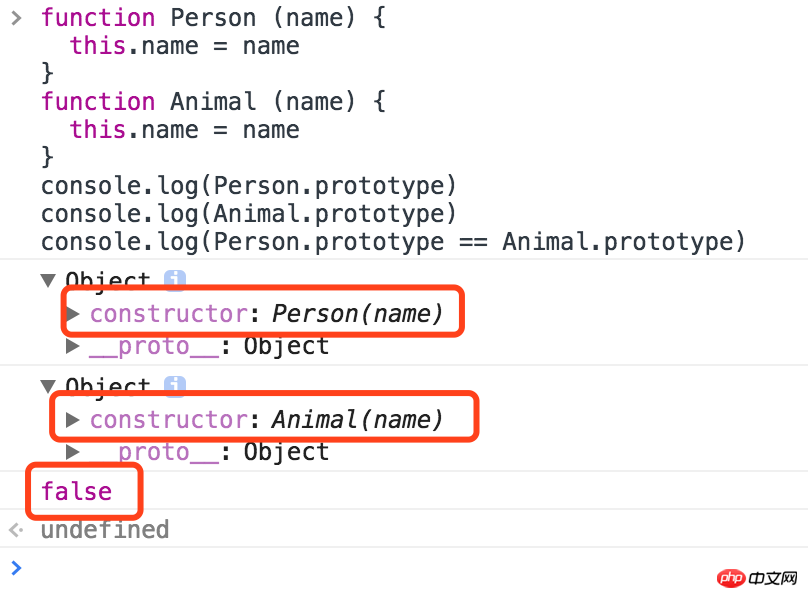
This` What is constructor`? It is a reference similar to a pointer, pointing to the constructor of the `prototype`, and the pointer must exist by default
1 console.log(Person.prototype.constructor === Person) //true
I just said that `prototype` is `Automatically generated`, in fact there is another manual way to generate `prototype`:
1 function Person (name) {2 this.name = name3 }4 Person.prototype = {5 //constructor: Person,6 age: 307 }8 console.log(Person.prototype) //Object {age: 30}9 console.log(Person.prototype.constructor === Person) //falseTips: In order to prove that it is indeed possible to manually create `prototype` for the constructor, here is `prototype` adds the `name` attribute.
Maybe you have noticed a problem, this line of code:
1 console.log(Person.prototype.constructor === Person) //false
Why is the result `false`? Brother, the `prototype` just now was generated by default, and then we used another method: manual setting. Let’s analyze the principle of manual setting in detail:
1. The `prototype` of the constructor is actually an object

2. When we set the `prototype` like this, in fact The original `Person.prototype` has been cut off, and then another object has been re-referenced

3. At this time, the constructor can find `prototype`, but `prototype `Constructor not found
1 Person.prototype = {2 //constructor: Person, // 因为constructor属性,我没声明啊,prototype就是利用它来找到构造函数的,你竟然忘了声明3 age: 304 }4. So, if we want to display the prototype of the manually set constructor without losing the connection between them, we have to do this:
1 function Person (name) {2 this.name = name3 }4 Person.prototype = {5 constructor: Person, //constructor一定不要忘了!!6 age: 307 }画外音:“说到这里,你还没有讲原型模式是如何实现属性与方法的共享啊”,不要急,马上开始:
对象实例-构造函数-原型,三者是什么样的关系呢?
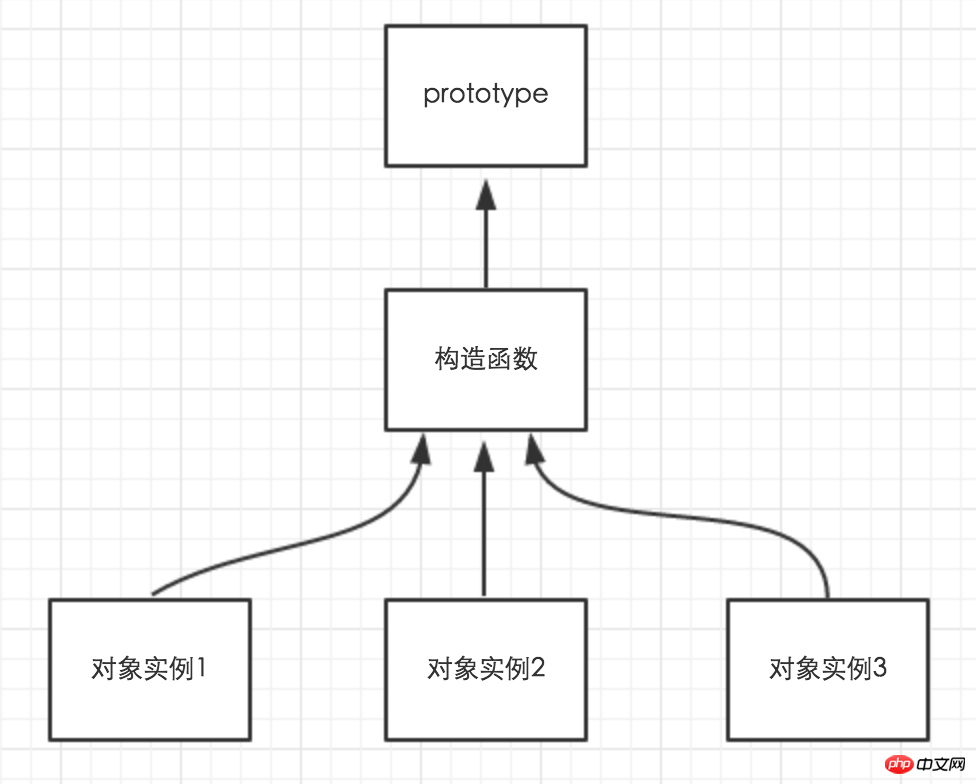

看明白这张图的意思吗?
1.当对象实例访问一个属性时(方法依然),如果它自身没有该属性,那么它就会通过`__proto__`这条链去构造函数的`prototype`上寻找
2.构造函数与原型是一对一的关系,与对象实例是一对多的关系,而并不是每创建一个对象实例,就相应的生成一个`prototype`
这就是原型模式的核心所在,结论:在原型上声明属性或方法,可以让对象实例之间共用它们
然后原型模式就是完美的吗?并不是,它有以下两个主要问题:
问题1:如果对象实例有与原型上重名的属性或方法,那么,当访问该属性或方法时,实例上的会屏蔽原型上的
1 function Person (name) {2 this.name = name3 }4 Person.prototype = {5 constructor: Person,6 name: 'lucy'7 }8 var p1 = new Person('jack');9 console.log(p1.name); //jack问题2:由于实例间是共享原型上的属性和方法的,所以当其中一个对象实例修改原型上的属性(基本值,非引用类型值或方法时,其他实例也会受到影响
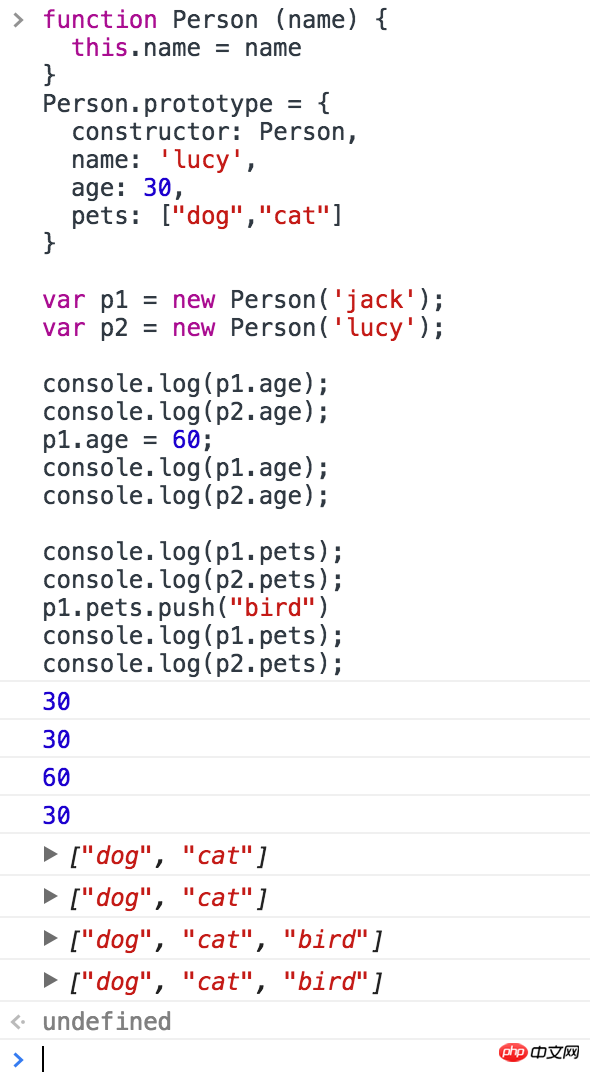
原因就是,当实例自身的基本值属性与原型上的重名时,实例就会创建该属性,留着今后自己使用,而原型上的属性不会被修改;但如果属性是引用类型值,如:`Array`、`Object`,当发生重名时,实例是不会拷贝一份新的留给自己使用的,还是坚持实例间共享,所以就会出现上图中的情况
以上两个问题就是原型模式的明显缺点,为了改掉这些缺点,我们一般会采用一种组合模式“组合使用构造函数模式和原型模式”,其实在原型模式这一节,该模式已经有所应用了
组合使用构造函数模式和原型模式
这种模式可谓是集构造函数模式和原型模式之所长,用构造函数模式来定义对象实例的属性或方法,而共享的属性或方法就交给原型模式
1 function Person (name) { 2 this.name = name //实例的属性,在构造函数中声明 3 } 4 5 Person.prototype = { 6 constructor: Person, 7 sayName: function () { //共享的方法存在原型中 8 alert(this.name) 9 }10 }注:此模式目前是ECMAScript中使用最广泛、认同度最高的一种创建自定义类型的方法
-----------------
下面要介绍的几个模式是针对不同场景的,而不是说`组合使用构造函数模式和原型模式`有什么缺点,又用这几个模式来弥补,不是这样的
动态原型模式
特点:共享的方法是在构造函数中检测并声明的,原型并没有被显示创建
1 function Person (name) { 2 this.name = name; 3 if (typeof this.sayName !== 'function') { //检查方法是否存在 4 console.log('sayName方法不存在') 5 Person.prototype.sayName = function () { 6 alert(this.name) 7 } 8 } else { 9 console.log('sayName方法已存在')10 }11 }12 13 var p1 = new Person('jack'); //'sayName方法不存在'14 p1.sayName(); //因为sayName不存在,我们来创建它,所以这里输出'jack'15 var p2 = new Person('lucy'); //'sayName方法已存在'16 p2.sayName(); //这时sayName已存在,所以输出'lucy'当`Person`构造函数第一次被调用时,`Person.prototype`上就会被添加`sayName`方法;《Javascript高级程序设计》一书说到:使用动态原型模式时,不能使用对象字面量重写原型。我们来理解一下:
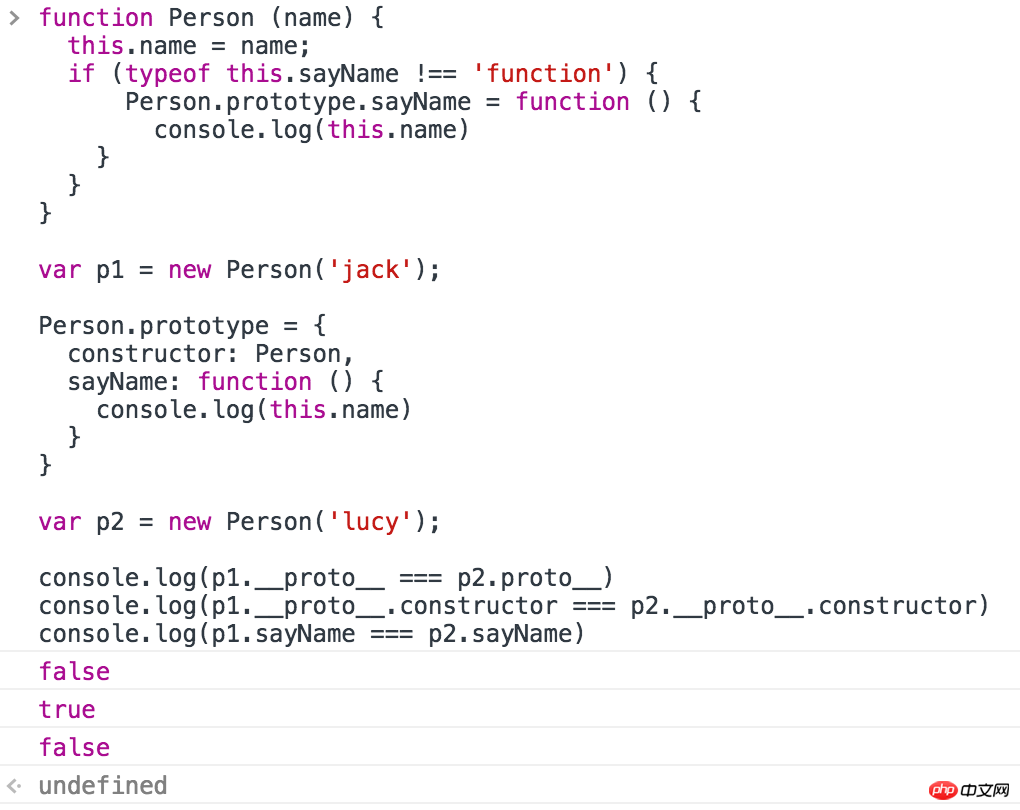
分析:
1.`p1`实例创建,此时原型没有`sayName`方法,那我们就为原型添加一个
2.随后,我们以字面量的形式重写了原型,这时旧的原型并没有被销毁,而且它和`p1`还保持着联系
3.之后的实例,也就是这里的`p2`,都是与新原型保持联系;所以`p1`、`p2`有各自的构造器原型,即使它们的构造器是同一个
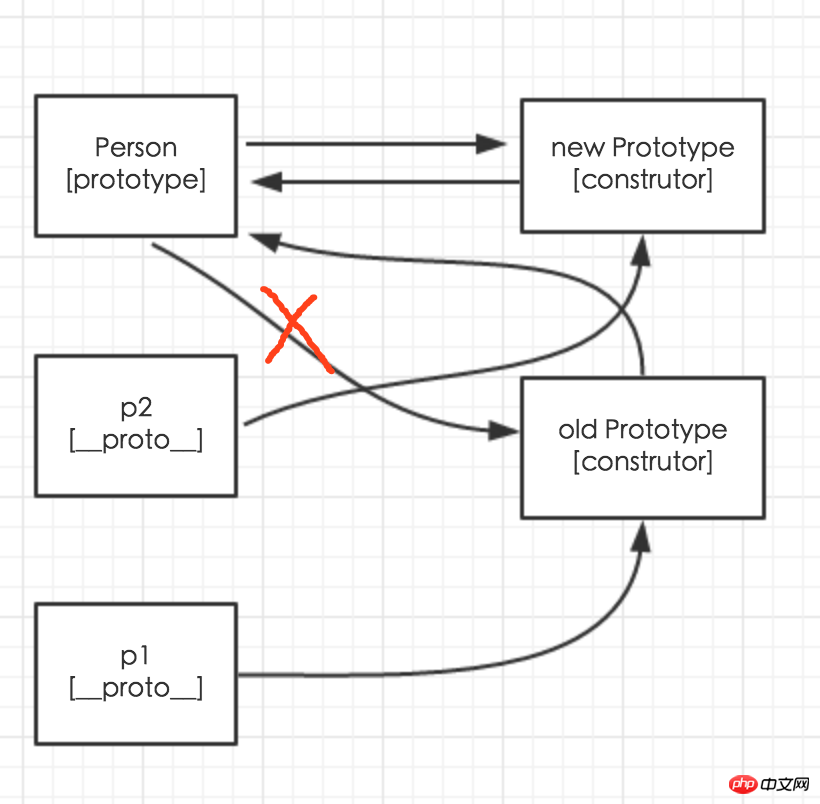
所以切记:当我们采用动态原型模式时,千万不要以字面量的形式重写原型
寄生构造函数模式
了解此模式之前,我们先来想一个问题:构造函数为什么要用`new`关键字调用?代码说话:
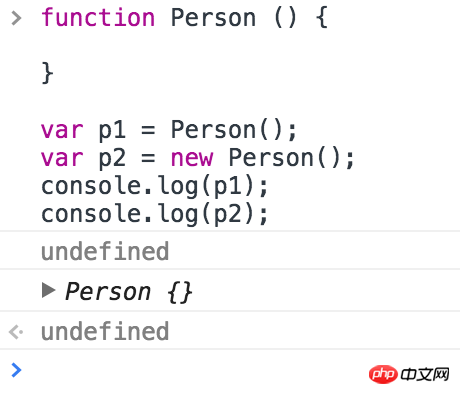
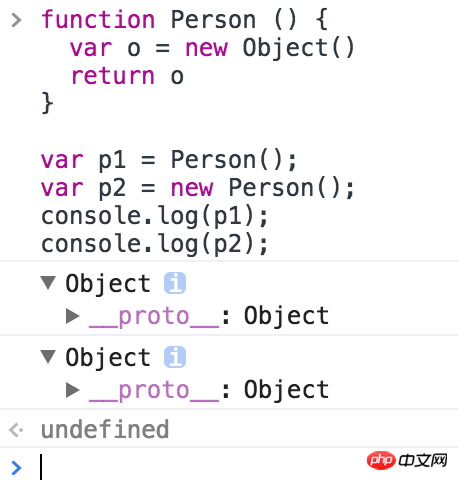
我们发现什么?如果不是`new`方法调用构造函数,那么就要显式的`return`,否则构造函数就不会有返回值;但如果使用`new`,那就没有这个问题了
下面我们再来看寄生构造函数模式:
1 function Person (name) { 2 var o = new Object(); 3 o.name = name; 4 o.sayName = function () { 5 alert(this.name) 6 }; 7 return o 8 } 9 10 var p1 = new Person('jack'); //与工厂模式唯一不同之处:使用new调用11 p1.sayName(); //jack其实new不new都无所谓,因为我们已经显式的return o
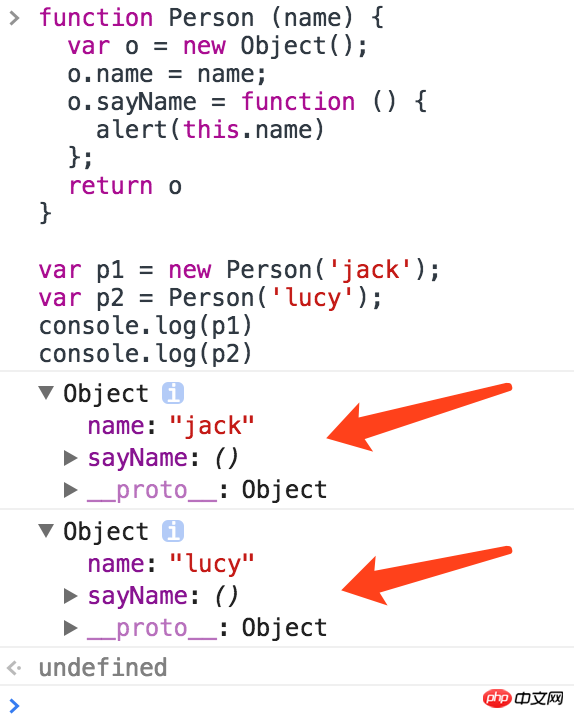
那么寄生构造函数模式到底有什么应用场景呢?据《javascript高级程序设计》一书记载,举例:如果我们想创建一个具有额外方法的特殊数组,那么我们可以这样做:
1 function SpecialArray () { 2 var values = new Array(); 3 Array.prototype.push.apply(values,arguments); 4 values.toPipedString = function () { 5 return this.join('|') 6 } 7 return values 8 } 9 10 var colors = new SpecialArray('red','blue','green');11 alert(colors.toPipedString()) //'red|blue|green'最后重要的一点:该模式和构造函数和原型无缘,也就是不能区分实例类型,因为该模式生成的实例,它的构造函数都是Object,原型都是Object.prototype
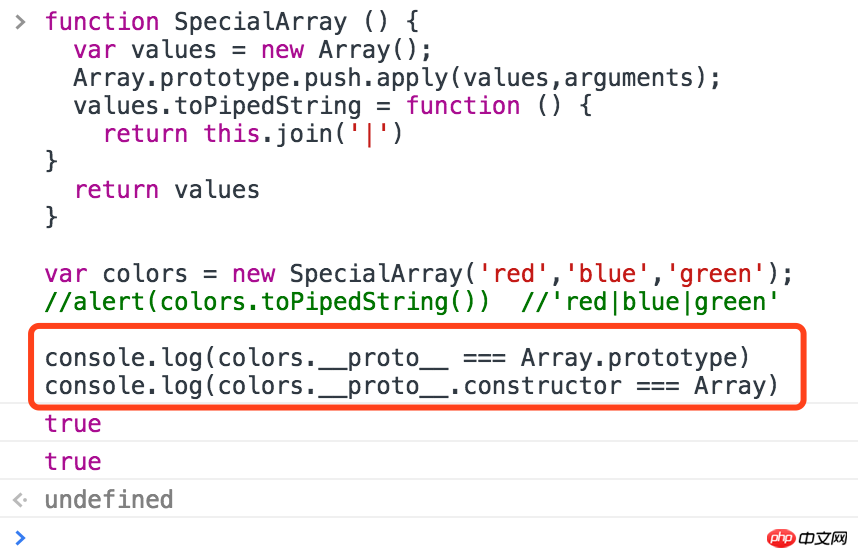
稳妥构造函数模式
该模式与寄生构造函数相比,主要有两点不同:
1.创建对象实例的方法不引用this
2.不使用new操作符调用构造函数
按照稳妥构造函数的要求,可以将前面的Person构造函数重写如下:
1 function Person (name) {2 var o = new Object();3 o.sayName = function () {4 alert(name) //这里其实涉及到了闭包的知识,因此产生了私有属性的概念5 }6 return o7 }此模式最适合在一些安全的环境中(这些环境中会禁止使用this和new),同理,此模式与构造函数和原型也无缘
结语
以上就是对js中创建对象的方式的总结,希望对大家有所帮助
The above is the detailed content of What are the common ways to create JS objects?. For more information, please follow other related articles on the PHP Chinese website!

Hot AI Tools

Undresser.AI Undress
AI-powered app for creating realistic nude photos

AI Clothes Remover
Online AI tool for removing clothes from photos.

Undress AI Tool
Undress images for free

Clothoff.io
AI clothes remover

Video Face Swap
Swap faces in any video effortlessly with our completely free AI face swap tool!

Hot Article

Hot Tools

Notepad++7.3.1
Easy-to-use and free code editor

SublimeText3 Chinese version
Chinese version, very easy to use

Zend Studio 13.0.1
Powerful PHP integrated development environment

Dreamweaver CS6
Visual web development tools

SublimeText3 Mac version
God-level code editing software (SublimeText3)

Hot Topics
 Analysis of the function and principle of nohup
Mar 25, 2024 pm 03:24 PM
Analysis of the function and principle of nohup
Mar 25, 2024 pm 03:24 PM
Analysis of the role and principle of nohup In Unix and Unix-like operating systems, nohup is a commonly used command that is used to run commands in the background. Even if the user exits the current session or closes the terminal window, the command can still continue to be executed. In this article, we will analyze the function and principle of the nohup command in detail. 1. The role of nohup: Running commands in the background: Through the nohup command, we can let long-running commands continue to execute in the background without being affected by the user exiting the terminal session. This needs to be run
 In-depth discussion of the principles and practices of the Struts framework
Feb 18, 2024 pm 06:10 PM
In-depth discussion of the principles and practices of the Struts framework
Feb 18, 2024 pm 06:10 PM
Principle analysis and practical exploration of the Struts framework. As a commonly used MVC framework in JavaWeb development, the Struts framework has good design patterns and scalability and is widely used in enterprise-level application development. This article will analyze the principles of the Struts framework and explore it with actual code examples to help readers better understand and apply the framework. 1. Analysis of the principles of the Struts framework 1. MVC architecture The Struts framework is based on MVC (Model-View-Con
 In-depth understanding of the batch Insert implementation principle in MyBatis
Feb 21, 2024 pm 04:42 PM
In-depth understanding of the batch Insert implementation principle in MyBatis
Feb 21, 2024 pm 04:42 PM
MyBatis is a popular Java persistence layer framework that is widely used in various Java projects. Among them, batch insertion is a common operation that can effectively improve the performance of database operations. This article will deeply explore the implementation principle of batch Insert in MyBatis, and analyze it in detail with specific code examples. Batch Insert in MyBatis In MyBatis, batch Insert operations are usually implemented using dynamic SQL. By constructing a line S containing multiple inserted values
 An in-depth discussion of the functions and principles of Linux RPM tools
Feb 23, 2024 pm 03:00 PM
An in-depth discussion of the functions and principles of Linux RPM tools
Feb 23, 2024 pm 03:00 PM
The RPM (RedHatPackageManager) tool in Linux systems is a powerful tool for installing, upgrading, uninstalling and managing system software packages. It is a commonly used software package management tool in RedHatLinux systems and is also used by many other Linux distributions. The role of the RPM tool is very important. It allows system administrators and users to easily manage software packages on the system. Through RPM, users can easily install new software packages and upgrade existing software
 Simple JavaScript Tutorial: How to Get HTTP Status Code
Jan 05, 2024 pm 06:08 PM
Simple JavaScript Tutorial: How to Get HTTP Status Code
Jan 05, 2024 pm 06:08 PM
JavaScript tutorial: How to get HTTP status code, specific code examples are required. Preface: In web development, data interaction with the server is often involved. When communicating with the server, we often need to obtain the returned HTTP status code to determine whether the operation is successful, and perform corresponding processing based on different status codes. This article will teach you how to use JavaScript to obtain HTTP status codes and provide some practical code examples. Using XMLHttpRequest
 Detailed explanation of the principle of MyBatis paging plug-in
Feb 22, 2024 pm 03:42 PM
Detailed explanation of the principle of MyBatis paging plug-in
Feb 22, 2024 pm 03:42 PM
MyBatis is an excellent persistence layer framework. It supports database operations based on XML and annotations. It is simple and easy to use. It also provides a rich plug-in mechanism. Among them, the paging plug-in is one of the more frequently used plug-ins. This article will delve into the principles of the MyBatis paging plug-in and illustrate it with specific code examples. 1. Paging plug-in principle MyBatis itself does not provide native paging function, but you can use plug-ins to implement paging queries. The principle of paging plug-in is mainly to intercept MyBatis
 An in-depth analysis of the functions and working principles of the Linux chage command
Feb 24, 2024 pm 03:48 PM
An in-depth analysis of the functions and working principles of the Linux chage command
Feb 24, 2024 pm 03:48 PM
The chage command in the Linux system is a command used to modify the password expiration date of a user account. It can also be used to modify the longest and shortest usable date of the account. This command plays a very important role in managing user account security. It can effectively control the usage period of user passwords and enhance system security. How to use the chage command: The basic syntax of the chage command is: chage [option] user name. For example, to modify the password expiration date of user "testuser", you can use the following command
 The basic principles and methods of implementing inheritance methods in Golang
Jan 20, 2024 am 09:11 AM
The basic principles and methods of implementing inheritance methods in Golang
Jan 20, 2024 am 09:11 AM
The basic principles and implementation methods of Golang inheritance methods In Golang, inheritance is one of the important features of object-oriented programming. Through inheritance, we can use the properties and methods of the parent class to achieve code reuse and extensibility. This article will introduce the basic principles and implementation methods of Golang inheritance methods, and provide specific code examples. The basic principle of inheritance methods In Golang, inheritance is implemented by embedding structures. When a structure is embedded in another structure, the embedded structure has embedded






